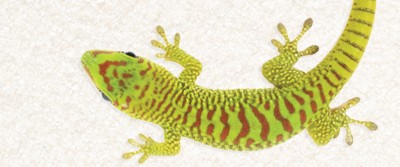Humans and Lizards in the Land of Dreams

By Mike Howie
Everyone, and everything, needs to sleep. Scientists aren’t quite sure why we need sleep, but it’s been proven time and again that nothing good happens when you don’t get enough of it. Efforts in studying sleep haven’t been entirely fruitless, though: It’s clear that there are multiple stages of sleep, and now we’re starting to learn that they might be more common between animals than previously understood.
Stages of Sleep
Generally speaking, there are two patterns of brain activity in sleep. The first is slow-wave sleep, which has four stages in humans. During all of these stages there is little activity going on in the brain. The other pattern is known as REM, or rapid eye movement, sleep. This pattern is associated with dreaming in humans and was previously thought to occur only in mammals and birds. These two patterns cycle back and forth throughout the night, with each cycle lasting about 60 to 90 minutes each in humans.
Sleepy Lizards
While monitoring the brain activity of lizards, a team in Germany noticed that they have two patterns of brainwaves while asleep. The first is 4Hz, a low frequency similar to slow-wave sleep, and the second is at 20Hz, a higher frequency similar to REM sleep. These patterns occurred in a cycle similar to the one in humans but at a shorter interval, lasting only 60 to 90 seconds each. To back this up, the researchers used an infrared camera to record video of the lizards while they slept, which clearly shows the lizards’ eyes twitching as they sleep. This doesn’t necessarily mean that lizards and other reptiles dream just like humans do, but it does tell us that our sleep patterns are older than we thought they were.
It’s all Relative
Lizards haven’t changed as much as humans have over the centuries, so studying their sleep patterns provides us with a new way to study where our own sleep patterns, as well as the sleep patterns of other animals, originated. They’ve already helped us to discover that our sleep patterns are about 300 million years old, which is much older than we had once thought. While we’re not quite there yet, it’s exciting to learn that we’re getting closer and closer to unlocking all of the secrets of sleep.
CLASSROOM DISCUSSION
The purpose of sleep is still unclear. Why do you think we need to sleep so often to stay healthy?
What could the brain be doing during REM sleep, and why are periods of REM sleep spread out?
VOCABULARY
- Slow-Wave Sleep
- REM Sleep
- Hertz